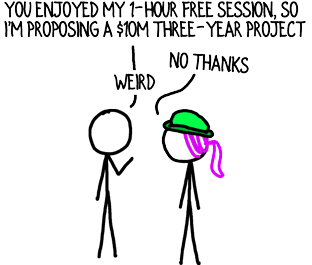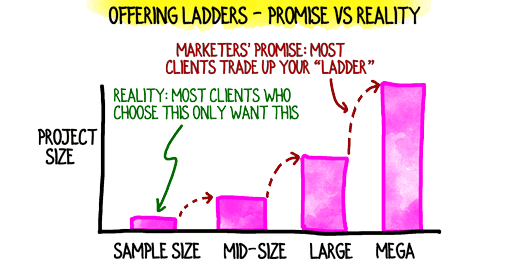If your consulting firm offers “sample size” projects such as workshops, training sessions, speaking gigs, or rapid assessments, you may be frustrated when clients don’t trade up to the full-size projects.

In theory, “foot-in-the-door” projects sound great. You run a small project with a client, then the clients loves you so much, they hire your consulting firm for the uber-megaproject.
It’s like a restaurant running a Happy Hour promotion in hopes that people will stay for dinner after they consume a couple of inexpensive drinks and a bowl of stale pretzels.
In practice, clients very frequently don’t trade up. (Happy Hour celebrators may or may not stay for dinner—any restaurateurs reading this can let me know in the comments.)
If you’re constantly running mini projects and not winning large engagements, your consulting practice is high churn, which puts stress on your BD engine and (for many consultants) less enjoyable.
There’s a place and a role for bite-sized engagements like workshops and training sessions. For instance:
- They may be part of your “bread and butter” stream of revenue.
- They can also derisk your client portfolio.
- They allow you to prove your quality and build trust with clients, which could open the gateway to larger engagements with your consulting firm.
Unfortunately, some consulting firms run workshop after workshop and are never considered for a large consulting project.
If that happens to your consulting firm, you can overcome constantly watching high-potential clients walk out the door once Happy Hour is over.
STEPPING UP THE FOOD CHAIN AT CLIENTS
Position Your Consulting Firm at the Top
If clients view your consulting firm as primarily a provider of workshops, trainings or other small projects, they won’t consider you a viable contender for their large project.
You don’t stay for dinner if you think the bartender is going to duck into the kitchen to whip up your meal. On the other hand, if the chef pops out to the bar to mix your drink, you’re appreciative of her attention and effort.
Position yourself as the chef, willing to conduct the small project even though that’s not your standard fare.
Sell Big from the Start
After a prospect contacts your consulting firm about a sample size project such as a training, workshop or small assessment, use your discovery process (a.k.a. Context Discussion) to elevate their thinking.
This uses the process of reframing, which I’ve written about elsewhere.
Use The Turn
An alternative approach during the Context Discussion is to use a variation on The Turn. It sounds like this:
We can absolutely run this workshop for you. Based on your Desired Outcomes, I have some ideas that may be very helpful for you. Are you open to a conversation about some other ways we may be able to create even more impact?
Present Large Alternatives
When you submit your consulting firm’s initial proposal for the small engagement, include at least one alternative that outlines a larger project.
Use The Overture
During your small engagement or once it’s over, break out The Overture, which is another variation on The Turn:
Totally separate from the workshop we collaborated on, would you be open to a conversation about ways we could potentially team up to help you achieve your objectives?
Use an Opportunity Review
Depending on the form and approach you employ during your sample size project, you may learn of other opportunities and gaps at your client. That learning could unlock your client’s wallet. Start with an Opportunity Review request:
While preparing for the training session we just ran for you, my team made a few observations we thought you’d be interested in. Are you open to a short meeting during which we can present what we saw?
Don’t go right for the project. Expose the need, gain agreement, then bust out The Turn again.
Of course, if your sample size project is all a client needs to sate their appetite, then they won’t be amenable to a larger project, no matter what technique you apply. Remember, consulting is about them, not your consulting firm.
Don’t try to win what your client doesn’t need!
How else have you successfully converted from foot-in-the-door, sample size projects to large engagements?
Text and images are © 2024 David A. Fields, all rights reserved.

 David A. Fields Consulting Group
David A. Fields Consulting Group 


I’m a big fan of your “The Turn” and have used it many times and recommended it to other fellow consultants, and “The Overture” is great variation.
The hotel I’m in gave me a handful of free drink coupons for their restaurant/bar – I wonder how many will convert to something bigger? So far just a quick nightcap 🙂
Good on you for adopting and employing The Turn, Ted. I also appreciate your field research at the hotel! Thanks for sharing your experience.
We used to do free or heavily discounted assessments and found out that we often didn’t get the next step. We now value price the intro/small projects so that we establish our pricing model and make good profit even on the small projects.
Fascinating case study, Bruce. Your experience mirrors what we’ve seen across many clients. Good on you for recognizing that small projects need to be priced for value too.
I appreciate your joining the conversation, Bruce.
I give away a WHYos discovery. Their interest level in learning more leads to an invitation only webinar with the founder of the Why Institute. Roughly 30 % opt to become certified. Once certified one in three of the individuals enters into a retainer agreement for my strategic marketing services.
Interesting case study, Jerry. Without knowing much about your practice and your market, it sounds like your offering is geared toward individuals rather than businesses. If that’s the case, it underscores a difference between marketing to corporate clients and marketing to individuals. That’s a whole additional, interesting topic of discussion!
I appreciate your sharing your experience, Jerry. Very intriguing.